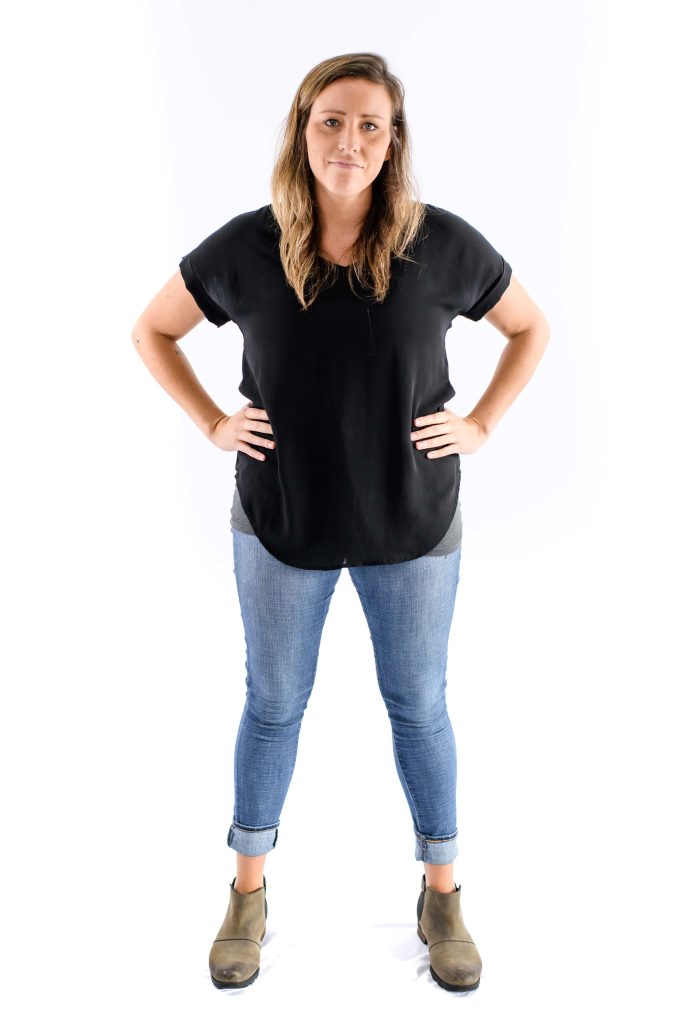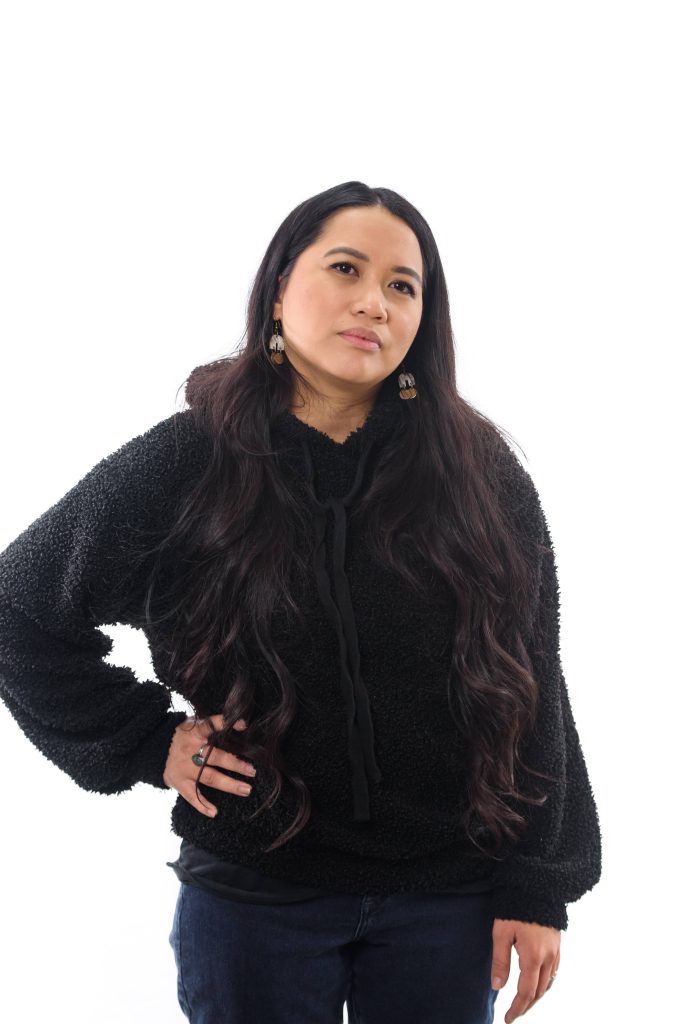This article is part of our body language guide. Click here for more.
While you may not be able to control your hip size (or have that ideal 0.7:1 waist-hip ratio, ugh!)…
You CAN control what your hips convey (and they tell a lot)!
In this guide, I’m going to show you 10 hip cues, including:
- the ultimate hip cue that signals confidence
- the #1 female hip cue that says she’s interested (it’s also Marilyn Monroe’s favorite!)
- why Hitler’s missing testicle forced him to use a certain pose (gross, I know)
- the sexiest dance moves, according to science

Can You Read Body Language?
How good are your body language skills? Take our free body language quiz to find out!
Hands on Hips Pose

Ready to put on your glasses and superhero outfit?
This is your classic “Superman” or “Superwoman” pose.
What it Means: When a person is confident and ready for action, you may see them strike this pose. It’s also a way of showing there are “issues,” “things are not good,” or “I am standing my ground” in a territorial display1https://www.amazon.com/What-Every-Body-Saying-Speed-Reading/dp/0061438294.
For example, after Margot Robbie says, “I’ve never eaten anything so spicy in my life,” while taking the Hot Ones challenge, she puts her hands on her hips to give herself reassurance. It’s a silent “I can do this!” display.
You might also see this gesture with:
- angry moms toward their crying children, in order to command attention and as a silent nonverbal warning
- professional models, to give the impression that their clothing is modern, assertive, and forward-thinking

- sports players who disagree with a referee’s judgment or game outcome
- flirty women who stick their hips to the side, emphasizing their waist-to-hip ratio and indicating fertility
Fists on hips is another variation and is usually done when someone is getting angry or aggressive.
Watch our video below to learn how to read people and decode 7 body language cues:
The Superman pose can also be super dangerous for some people:
In numerous interviews, criminals reveal that this territorial arm display is one of the things they look for in trying to identify undercover officers, since police officers often use this gesture to command authority2https://www.amazon.com/Definitive-Book-Body-Language-attitudes/dp/1409168506.
How to Use it: Chances are if you’re an introvert, you will not often use this pose in public. Flaring the elbows out makes people appear bigger and more noticeable, and introverts often shy away from this behavior…
HOWEVER, there is a science of power poses, and this is an amazing gesture to use to look and feel confident.
Hand on Hip

Moving on, we have ONE hand on the hip instead of 2.
If you’re anything like me, you can clearly picture your mom scolding you with her hand on her hip. The conversation probably went something like this:
- “Yes, Mom. I’ll clean my room.”
- “OK, Mom, I’ll eat dinner later!” or
- “I don’t know when I’m going to get married, Mom! I’m only 14.”
What it Means: This is the ultimate “you’re about to cross the line” gesture. The key here is to pay close attention to when this cue happens. If you say to your coworker, “You seem like you’re high on the openness scale!” and you immediately see her place her hand on her hip, chances are she thinks otherwise.
On the other hand, this can also just be a relaxing position, so be careful in making a judgment call, especially if there’s no trigger.

How to Use it: This cue is especially useful during negotiations or meetings. For example, at a Microsoft training I gave last week, I mentioned to the IT team that yes, you can even read body language on video calls!
However, I noticed that the manager of the team immediately placed his hand on his hip and raised his eyebrow. He quickly expressed, not to my surprise, that reading body language would be difficult since all you see is someone’s face.
And this is the best part:
Immediately after I explained that pushing the webcam back to show your hands is a great solution, the manager dropped his hand back to his side and said that was an “excellent solution.”
Curious Hands on Hips

With this display, the arms are pointed outward with the thumbs pointing forward.
What it Means: “Curious Hands on Hips” is an inquisitive display, and is often seen when observing witnesses of tragic events, such as car accidents2https://www.amazon.com/Definitive-Book-Body-Language-attitudes/dp/1409168506.
If the thumbs are back, however, it would turn into an authoritative and dominant display (what I call the Superman pose)—that’s why police officers and firefighters may use this gesture, but with their thumbs pointing backward.
How to Use it: If you’re angry with your spouse/kid/friend and catch yourself in this position with your thumbs facing backward, try immediately shifting your thumbs to point forward. You may start to feel more inquisitive and try to look for an answer rather than feel argumentative.
Bowing

Does this guy seem trustworthy to you?

In this photo, John Krasinski is bowing down. He is also smiling and has his elbow out, still showing confidence.
What it Means: Bowing at the hips is a submissive gesture that says, “I’m harmless!” The lowering of one’s hips makes the bower appear smaller, humble, and more submissive. We love this because it is a sign of respect, and this is also why bowing has remained popular with many theater and performance artists.
You can also see this with subordinates in the workplace. If an employee walks into a room with his boss or other C-level executives, you’ll often see him give a slight bow at the hips as a sign of respect.
And if you take it to the next level, you get Japanese bowing (aka kowtowing).
…And even further than that, you get begging:
Fun Fact
Did you know that in earlier times, people actually kissed the dirt in which a superior stood? If allowed, they may then move up to the hem of a garment, to the knee, and even kiss the hand depending on the person’s status1https://www.amazon.com/What-Every-Body-Saying-Speed-Reading/dp/0061438294.
Special Note: There is one caveat to bowing to superiors when sitting: When a higher-ranking person enters the room, others typically stand to greet them3https://www.amazon.com/Peoplewatching-Desmond-Morris-Guide-Language/dp/0099429780. This means the superior can relax, but the subordinate isn’t allowed to.
How to Use it: Bow to show respect. The greater the bow, the more respect—but stay modern and don’t overdo it. And if you’re wearing a hat? You can achieve the same effect by removing it. This effectively reduces your height, just like bowing.
Close Hips

Last Christmas, I was at my close friend’s annual ugly Christmas sweater party—yes, it was an ugly Christmas sweater party.
She met a really interesting girl who was a big analyst for a Fortune 500 company. It looked like they were really hitting it off—but when they parted ways, their hips were far apart!
How far?
“Imagine a pool of hot lava 1 foot away from you” type of far.
What it Means: If someone’s hips are close to you as you hug them, this is an indication of intimacy. Couples commonly hug close together, but strangers usually keep their hips at a safe distance apart.
How to Use it: It’s not just for hugs, either. The next time you’re in a conversation, pay attention to how close your hips are to the other person. This is likely a good indicator of your level of attraction, comfort, or familiarity.
The Hip Shift

Last Thursday, my husband Scott and I went to a nearby dim sum restaurant (P.S. we LOVE Cantonese food!).
As we were going over our deep questions that we do at least once a year, I asked Scott a question and noticed him shifting in his seat. I immediately knew he was mentally rummaging through some bad memories (by the way, this was question number 29 on the list!).
What it Means: When someone shifts their hips in their seat, this might mean one of 3 things:
A. They’re stressed.
B. They’re bored.
C. They’re just fatigued from sitting.
How do you know? See if the hip-shifting is accompanied by other gestures. If they are gazing overhead, they are likely B. bored. If they are anxiously biting their nails, they are likely A. stressed. If they seem calm and happy, it’s likely they are just fatigued.
Hip-shifting is rarely seen between couples early in a relationship—but as the relationship progresses, you may see this shifting occur if important (and uncomfortable) issues are being discussed2https://www.amazon.com/Definitive-Book-Body-Language-attitudes/dp/1409168506.
You might also see this during hotly contentious arguments where 2 people are duking it out to win. In this case, shifting helps calm people down during these debates2https://www.amazon.com/Definitive-Book-Body-Language-attitudes/dp/1409168506.
How to Use it: If you see this hip-shifting gesture occur, keep in mind the topic you’re talking about. In my case, Scott brought up a super awkward/embarrassing experience from when he was a kid, and I knew this was coming by observing his hip-shifting.
Hip Swaying
Have you ever caught yourself moving your hips back-and-forth, side-to-side, while waiting in line at the DMV or grocery store?
What it Means: This hip-swaying gesture looks like you’re cradling and rocking a baby to sleep, and it’s done mostly when we’re bored. Science shows that this swaying motion causes the fluid and hairs in our inner ear to move subtly, which soothes us2https://www.amazon.com/Definitive-Book-Body-Language-attitudes/dp/1409168506.
And the faster the hips sway, the more aggressive/impatient/restless a person may be.
How to Use it: If you spot someone swaying their hips during a conversation—and you’re not dancing the night away at a party—then that’s your cue to gracefully end the conversation and move on.
The Monroe Walk
Do you ever notice how some women have a natural “sway” to their hips when walking, the type of sway that invites attention and is alluring?
Take that hip-swaying and transfer it to walking, and you’ve got the Monroe Walk.
Marilyn Monroe reportedly4https://www.theguardian.com/fashion/2011/nov/15/marilyn-monroe-film-costume-designer shaved a half-inch off one of her heels to emphasize this walk. Watch how Marilyn Monroe’s hips move back-and-forth like a pendulum in this clip:
What it Means: Women naturally have wider hips, causing us to walk with a *ahem* sexy sway. But if you notice her movin’ and groovin’ her hips more than normal, you can almost bet she’s showing off her goods to a potential mate nearby.
Got Rump?
Did you know Gelada baboons openly show their sexual readiness… on their chest?
Their chest is pretty much an exact copy of her bum:
Source
And when a female is in heat and ready to mingle? The color on her chest intensifies and becomes redder1https://www.amazon.com/What-Every-Body-Saying-Speed-Reading/dp/0061438294. This makes sure any approaching male can tell her sexual condition just by looking at her chest!
How to Use it: Pay attention to how a woman walks, especially if you’re on a date. The perfect time is when she gets up to go to the bathroom (just don’t get caught peeping!). Women who are attracted to you may be more self-conscious than normal, and shake their hips to look more appealing.
The Belt Buckle Pointer

This gesture is usually done by men* (*big belt buckle may or may not apply). You’ll see this when men put their hands near their privates with their thumbs either pointed toward their belt buckle or private area.
Sometimes, you may even see thumbs going INSIDE the pants… although that’s mostly left mostly for raunchy situations.
What it Means: Imagine an old Western scene with a rough ’n tough cowboy. He’s standing under the hot sun, eyeing his rival and has his thumbs pointing to his bull horn belt buckle. This cowboy’s the toughest cowboy in Kansas, and he knows it. He’s proudly displaying his family jewels, signaling to his rival that he’s the big boy in town.

Besides being a territorial display, men also use the belt-buckle-pointing gesture around women to signal health and virility2https://www.amazon.com/Definitive-Book-Body-Language-attitudes/dp/1409168506. That’s why you may see a group of men standing around with their hands to their sides, and as soon as an attractive lady joins the group, the alpha male will strike this pose.
Funny enough, you may even see apes do the same gesture (without belt or trousers, of course) at the zoo.
How to Use it: Since belt-buckle-pointing is a highly confident signal, you can use it to “unconsciously” throw in a little playful flirtation toward a potential partner. And yes, girls can do this, too.
But be careful when using this around the wrong people—those who feel in power might feel intimidated or aggressive if you display this pose too proudly.
Hands Over Groin (Fig Leaf Position)

If you’ve ever watched someone receive an award or forced to awkwardly stand in front of their peers while giving a presentation, you might have seen this cue.
What it Means: This is known as the “fig leaf” position and usually indicates discomfort or a need for reassurance.
Adolf Hitler used this gesture a lot to mask inadequacy of having only one testicle.

And in the following video of the Big 3 leaders of 1945—Winston Churchill, Franklin D. Roosevelt, and Joseph Stalin—can you tell who has the most power? (timestamp 3:08)
First, notice their locations. Both leaders are responding well to Roosevelt, who is in the middle. Generally, the one in the middle is always the one who has the most power.
And what’s more interesting is when you look at Churchill on the left. His elbows are out, but the most important cue is that he’s covering his private parts with his hat:

If I had to guess, based on his nonverbal, he was feeling vulnerable and not as confident in this meeting. Coincidentally, this also correlates with Britain’s low status during this time period1https://www.amazon.com/What-Every-Body-Saying-Speed-Reading/dp/0061438294.
Do You Dance Sexy?
Science confirms it: there’s a way of dancing that can make you attractive, sexy, and irresistable.
And the key is in the hips.
The study5https://www.nature.com/articles/srep42435, published in 2017, showed digital dancing avatars to groups of heterosexual men and women. The data gathered suggests that we like women dancers who swing their hips and thighs to the groove, along with swinging a bit of their arms.

Gyrating the hips signals fertility. And it is anti-boring since hip movements separate simple dancers from the advanced ones who use complex moves.
And when it comes to body language…
Just like dancing, hip body language can be complex—a small movement just ½ an inch can convey great meaning.
That’s why you’ve got to practice your observational skills and ALWAYS stay focused during any interaction.
Oh yeah, and for male dancers? It’s not so much the hips but all in the neck and torso, with a lot of right knee movement.
Or, you can say “to heck with it” and dance without care like Elon Musk:
The Best Body Language to Learn
Do you know the most important body part that gives away a person’s intentions?
Hint: It’s not the hips… even though they are a great indicator and super useful.
You see, I like to think of the human body from bottom to top.
The key to reading body language is to start with the ground first.
Why? Because we can easily lie with our face, control our arm and hand gestures, and even smile with our eyes.
But most people don’t pay attention to their feet!
So if you haven’t read our feet guide yet, I highly recommend doing so! You’ll learn so much, like how to know you’re “in” with a group or how to tell she’s into you:
Feet Behavior – The Untapped Body Language You Should Know
How did you like our hips article? Do you have another juicy tip to add? Let me know in the comments below!
Crack The Code on Facial Expressions
The human face is constantly sending signals, and we use it to understand the person’s intentions when we speak to them.
In Decode, we dive deep into these microexpressions to teach you how to instantly pick up on them and understand the meaning behind what is said to you.
Don’t spend another day living in the dark.
Side note on our research: As much as possible, we tried to use academic research or expert opinion for this master body language guide. Occasionally, when we could not find research, we include anecdotes that are helpful. As more research comes out on nonverbal behavior, we will be sure to add it!
This article is part of our body language guide. Click here for more.
Article sources
- https://www.amazon.com/What-Every-Body-Saying-Speed-Reading/dp/0061438294
- https://www.amazon.com/Definitive-Book-Body-Language-attitudes/dp/1409168506
- https://www.amazon.com/Peoplewatching-Desmond-Morris-Guide-Language/dp/0099429780
- https://www.theguardian.com/fashion/2011/nov/15/marilyn-monroe-film-costume-designer
- https://www.nature.com/articles/srep42435
4 thoughts on “What Does the Hands on Hips Pose Mean? 10 Hip Cues to Know”
Comments are closed.
How to Deal with Difficult People at Work
Do you have a difficult boss? Colleague? Client? Learn how to transform your difficult relationship.
I’ll show you my science-based approach to building a strong, productive relationship with even the most difficult people.

so interesting agree with alot of it but I have multiple views that I feel were over looked
so interesting agree with alot of it but I have multiple views that I feel were over looked
so interesting agree with alot of it but I have multiple views that I feel were over looked
so interesting agree with alot of it but I have multiple views that I feel were over looked